Project Management Guide For Executive Assistants
An executive assistant's project management skills can form the backbone of your organization’s health. Learn how to level up your leadership qualities.
High-level executives’ broader responsibilities benefit the company as a whole – and keep the execs pretty busy. Your C-suite is kind of like a bunch of ship captains making sure their vessel stays in one piece. An executive assistant is more like the first mate, who focuses their talents inward to care for the finer details. While the CEO is the mover and shaker that helps the company grow, you’re doing the groundwork for them to do all that.
That’s why project management for executive assistants is so important. Keeping your C-suite organized while they do their work can keep the organization running smoothly. Below, learn how to be a great project manager as an executive assistant.
- What is project management?
- Phases of project management for executive assistants
- 6 tools for project management for executive assistants
- Tips for project management as an executive assistant
What is project management?
Project management is an organizational skill that helps teams tackle both simple and complex projects in the shortest amount of time. With this faster timeline often comes higher-quality work too. While keeping track of tasks and deadlines falls under project management, it also involves advanced problem-solving, communication skills, and a proactive mindset. You’ll typically see project managers as team leaders, but staying organized is valuable in solo projects too.

Level up your project management skills
A well-run meeting can foster communication and collaboration by including an agenda the whole team can contribute to. Try using a tool like Fellow!

Phases of project management for executive assistants
Project management means more than organizing your project. It’s also about going into it with a different mindset to get the best results. You can use the five phases of project management to reshape how you view it and better manage your projects.
1Planning
When there’s a project on your plate, jumping right in can be pretty tempting so that you get it done as fast as possible. And while that’s not a bad attitude, going in without taking a moment to look over what’s expected can lead to mistakes. That’s why, in the planning phase of project management, you’ll take a step back to ask questions about your new project and see what’s needed.
Take this time to understand the project’s scope and timeline as well as your team members’ abilities. Without this step, you might not use your resources to the fullest. Or, in executive assistant terms, the planning phase means learning what the executive suite wants to accomplish in the near future. You’ll then need to research and figure out the best way to get them there.
2Initiation
Once you know as much as possible about the project, it’s time to break it down into smaller, more manageable tasks. This initiation phase is where you’ll create milestones and set deadlines along your way to the project’s overall due date. Having a set schedule for deliverables helps organize your own day-to-day responsibilities and create a timeline for your executives. It also helps you take smaller tasks, such as scheduling meetings, off their plates.
3Execution
The execution phase is where work on the project officially begins. Generally, this is where the executive can go and perform their duties while you focus on other work. Most executive assistants find some relief during this phase because they’re done setting up the project and don’t have to carry it out.
4Performance and resource tracking
While the work is getting done, you should keep an eye on its progress. You never know when issues will come up that need direct action to resolve. Paying attention to the project helps ensure that any gaps close up before they become bigger problems.
Additionally, monitoring a project’s progress can help you be sure that your executives are using them appropriately. There’s usually only so much money that your organization can throw at one task – going over budget isn’t worth crossing the finish line.
5Review
Most projects end with everyone immediately moving on to the next one, so it’s tempting not to pause and reflect. However, you should always make time afterward to review how the project went. This can help you handle issues faster in the future.
Of course, your executives have likely done a lot of the work. But that doesn’t mean you can’t learn anything from a review! Using your most recent experience to guide the next one can always help you more efficiently get through the planning and initiation phases.
6 tools for project management for executive assistants
Keeping track of all the nitty-gritty details of your executives’ days can get tedious. That can lead to mistakes – sometimes big enough to grind your usual processes to a halt. The below project management tools can help you avoid errors and take your executive assistant project management skills to the next level.
1OneNote
Administrative professionals can get a lot from leaving notes for themselves to help them keep track of everything. But if you work somewhere for long enough, you’ll have a lot of information to keep track of, and some of it could get lost. Microsoft OneNote can help you keep that from happening.
With Microsoft OneNote, you get plenty of tools for organizing your notes. You can also easily share notes with other people to get information in front of them. It also comes with a free-draw mode so you can add more to your notes.
Key features:
- In-depth organization tools
- Easy note sharing
- Free-drawing mode
Price: Microsoft OneNote starts at $6.99 per month for individual use as part of Microsoft 365. For business, Microsoft OneNote starts at $6.00 per person per month.
2Fellow
Meetings are often a fact of life at work, and that’s especially true for executive assistants. With the professional meeting program Fellow, your meetings run smoother than ever with. You can use Fellow to collaborate on meeting agendas and use meeting templates to prepare more efficiently. You can also create meeting action items in real-time to help your team members prioritize tasks. And that’s only the start with this comprehensive meeting platform.
Key features:
- More effective collaboration on meeting agenda
- Meeting templates to more quickly prepare for meetings
- Assign and track meeting action items
Price: Fellow offers a free plan for teams of up to 10 people. For larger teams, the cost is $6 per person per month.
3Monday
Using Monday, you can keep your entire team’s work schedule at your fingers – and so can your team. You can use Monday’s customizable dashboards to track your team’s timelines, goals, and budget. You’ll also get real-time updates upon project completion. And with Monday’s document tools, you can share and edit real-time notes too.
Key features:
- Custom dashboards for project tracking
- Real-time updates when tasks are completed
- Shared work documents
Price: Monday offers a free introductory tier. Paid plans start at $8 per person per month.
4TripIt
Travel is often an important part of a CEO’s job, so making travel plans is essential to your job as an executive assistant. Tripit makes that work easier. You can use it to create itineraries after you book flights and hotel rooms. Your executives can use it while they’re traveling to quickly see how to get from one place to another. They can also use it to plan out activities while they’re on the road.
Key features:
- Create itineraries for travel
- Find the best route from point A to point B
- See notable places close to hotel
Price: TripIt offers a free basic plan. You can purchase a plan with more advanced features for $49 per year.
5Slack
Slack has become the bread and butter of team communication. The platform is built for ease of use with its simple-to-understand interface and design. You can use it for group chats or one-on-one messaging, and you can create channels for team-wide announcements. There are also audio tools so you can quickly speak with your executives in real-time without a whole big phone call.
Key features:
- Chat with groups or just one person
- Organize chats by topic with channels
- Use audio tools to quickly reach executives with no phone call
Price: Slack offers a free tier. Its paid plans start at $6.67 per month.
6CalendarX
Scheduling is a huge part of project management, and CalendarX helps you make timetables available to everyone. Instead of scheduling things in a meeting and jotting them down, you can communicate upcoming deadlines and events directly through the calendar instead. Whenever you update your calendar, everyone you’ve shared it with in the C-suite gets notifications. You can customize your calendar to work for you in whatever ways you need.
Key features:
- Add deadlines and events to a shareable calendar
- Automatically update your C-suite about upcoming events and deadlines
- Customize your calendar in several ways
Price: Calendar does not list pricing on its website.
Tips for project management as an executive assistant
While you might have the tools you need to best use your project management skills, there’s more to project management than technology. Keep the following tips in mind while planning your next project.
Think ahead
Looking at the problem right in front of you is a great start, but it shouldn’t be the end. If you focus only on the now, future problems will more likely blindside you. And sure, it’s impossible to figure out every possible issue that might come up during a project. But thinking of solutions to even a few possibilities right now can help you stay on track. Additionally, thinking ahead can help you adapt to challenging situations.
Always plan for the worst
Will the worst always happen? Probably not. But it always can, so it’s best to be prepared. Knowing what to do in the worst-case scenario can give you valuable insights into how to handle smaller problems too. It’s a great way (if not a bit anxiety-inducing) to get yourself ready for even the most out-there of hurdles.
Keep an eye on the details
The broad strokes of any project are important, but the little things matter too. Overlooking tiny details can result in your executives needing to redo certain work, which won’t be a good look for you. Project manager for executive assistant means getting up close and personal with your budget, deadlines, and any changes to your C-suite’s goals. This can help you avoid any surprises and adapt to any changes.
Collaborate with others
As an executive assistant, you’re always working with other people – namely, your organization’s executives. But why stop there? Getting help from others within your organization as you plan your executives’ projects can help you solve problems that might be stumping you. Sure, you’ll be the primary person setting the score for your executives, but the more buy-in from across your organization, the better.
Steer your next project in the right direction
Project management for executive assistants means thinking smart in both the short term and long run. In the planning phase, it might involve a whole lot of meetings, and you can use Fellow to run your meetings smoothly. With collaborative agenda tools, real-time note-taking features, and clear meeting action items, you can plan, run, and follow up on topics like a pro.






![Tips for Writing an Effective Executive Summary [+ Example]](https://fellow.app/wp-content/uploads/2022/05/Writing-an-Effective-Executive-Summary.jpg)


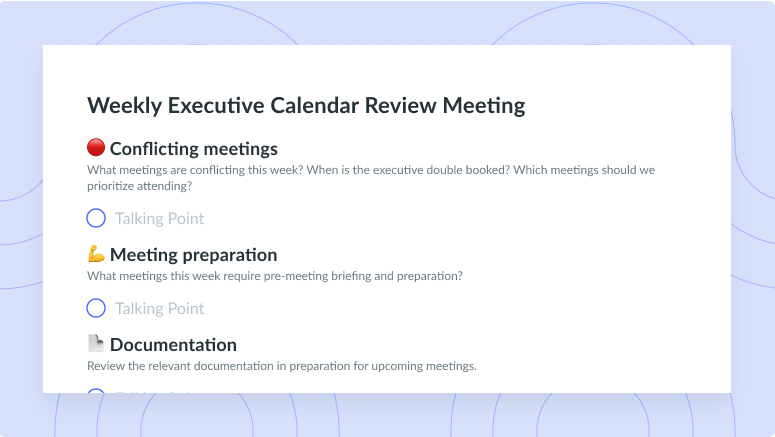
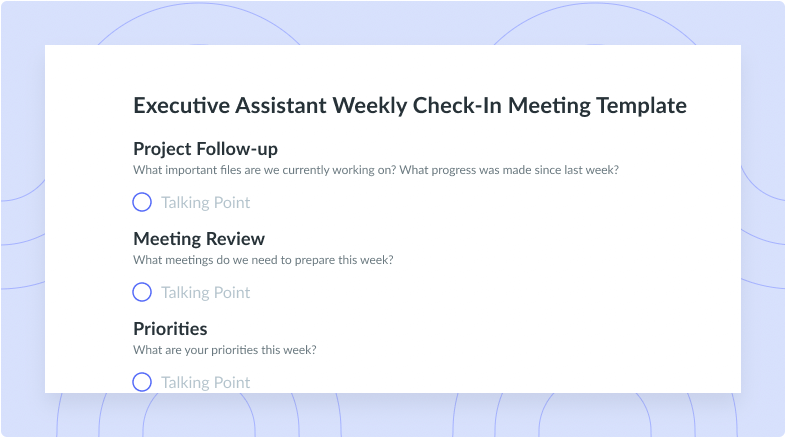
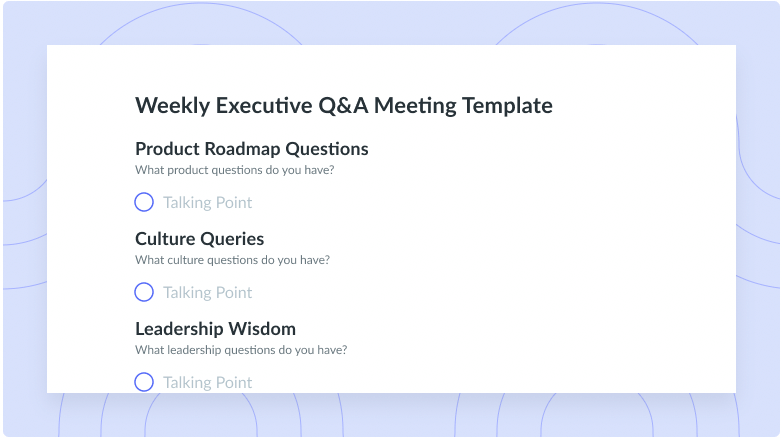
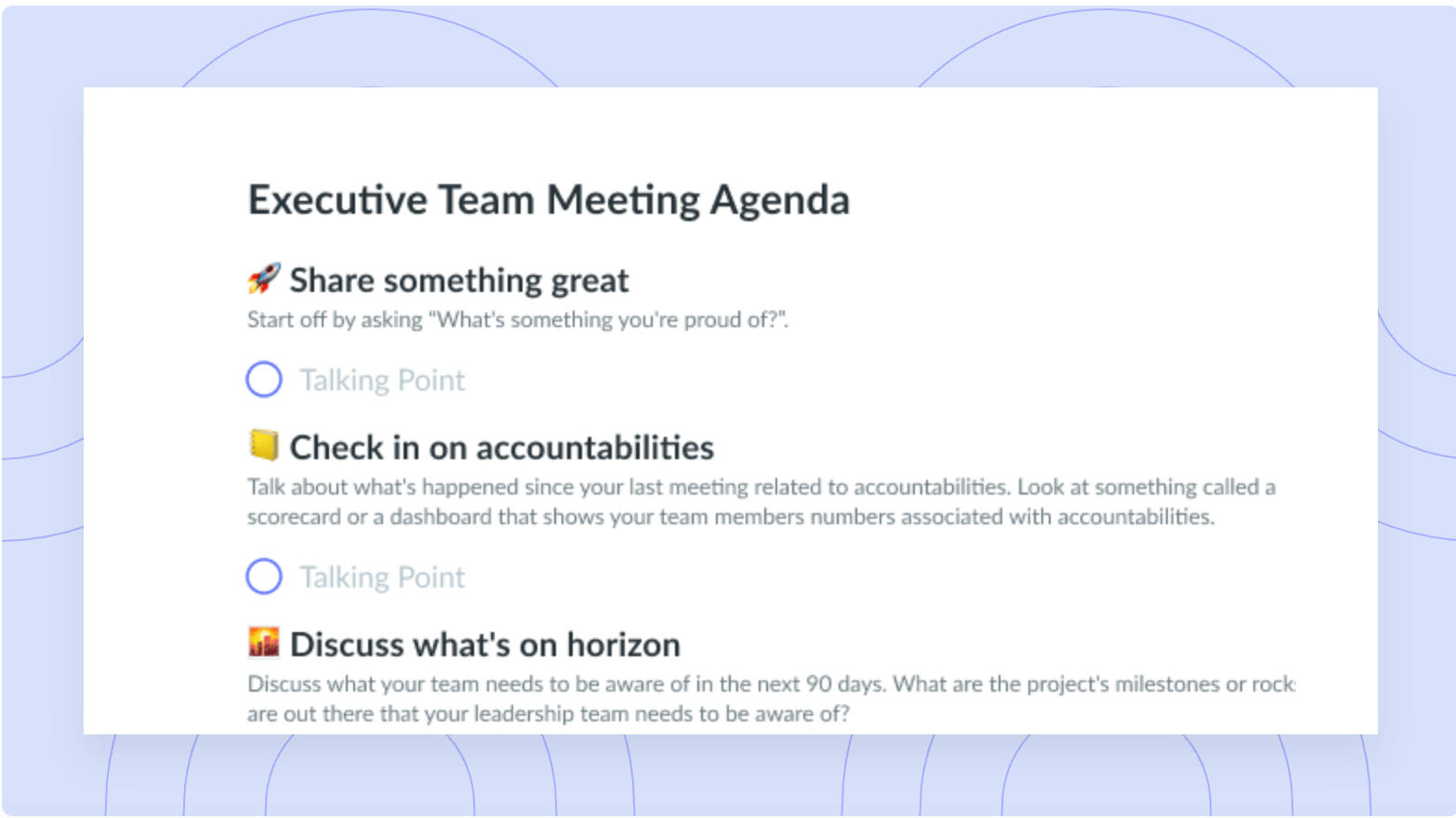

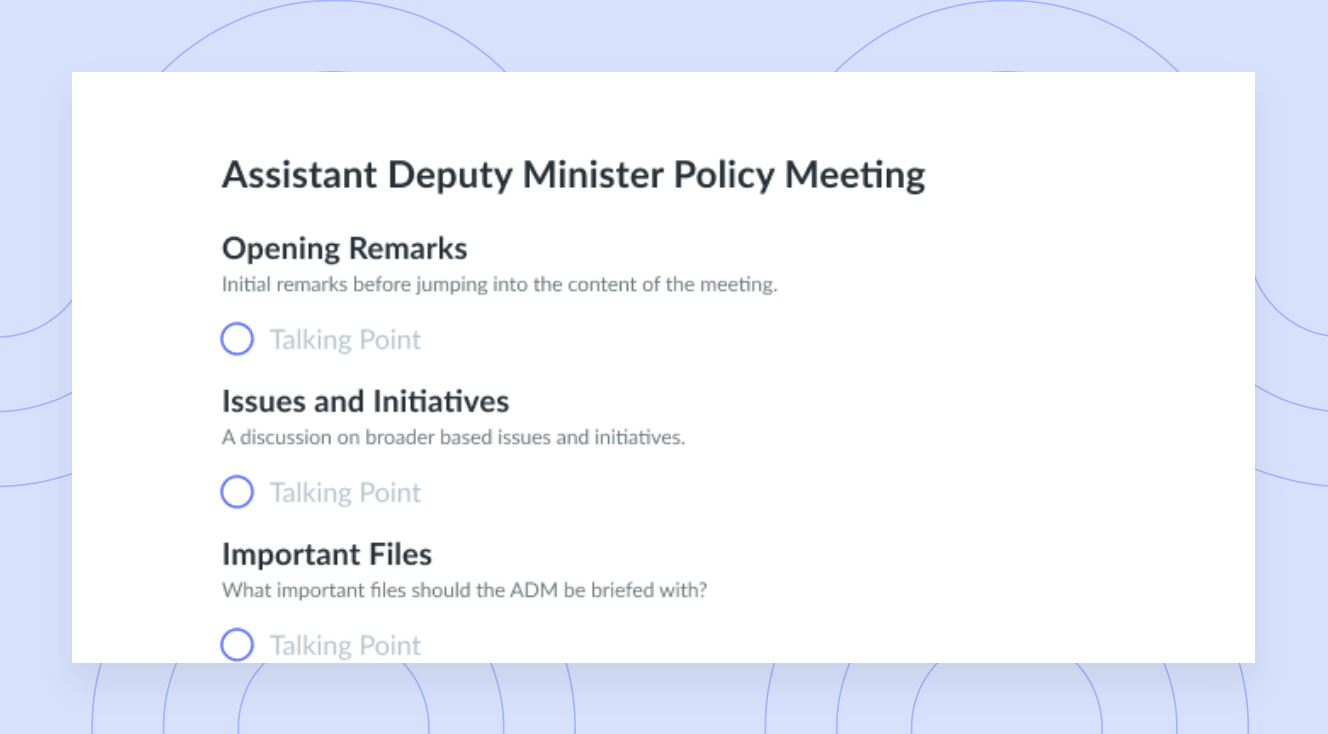
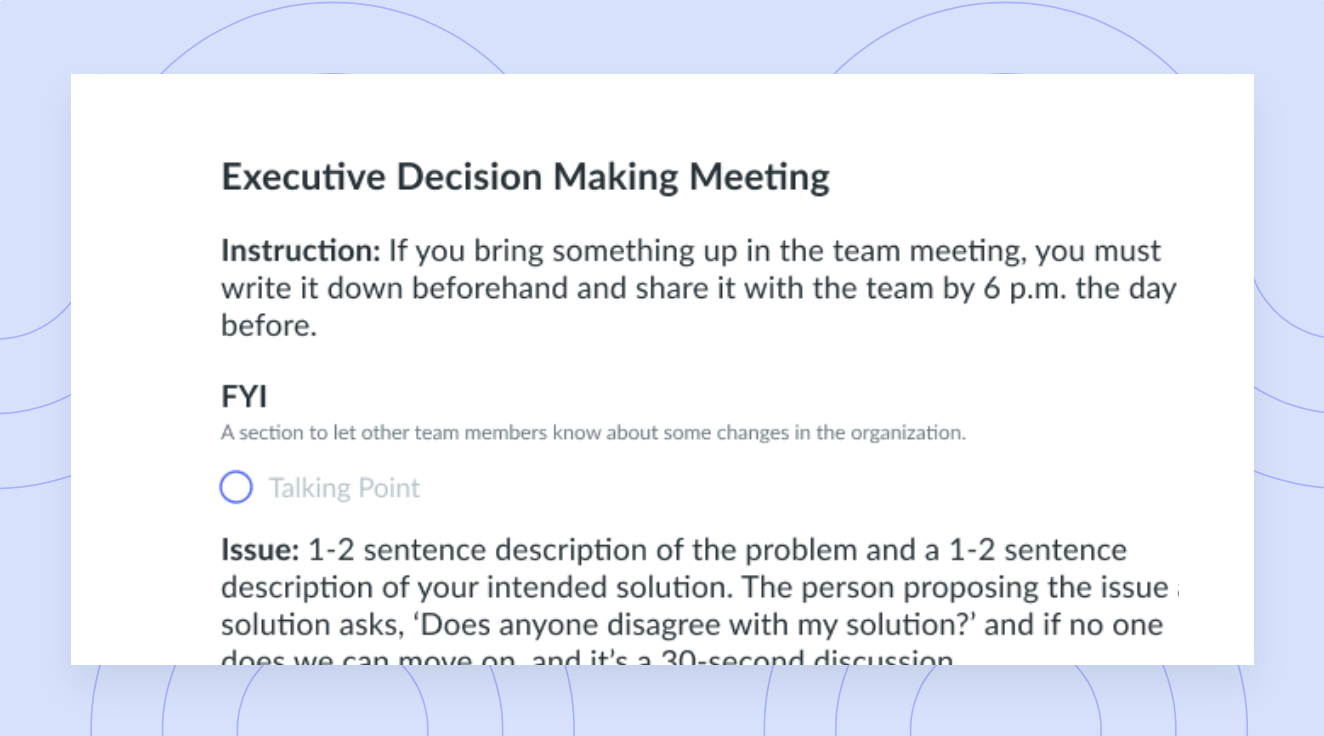
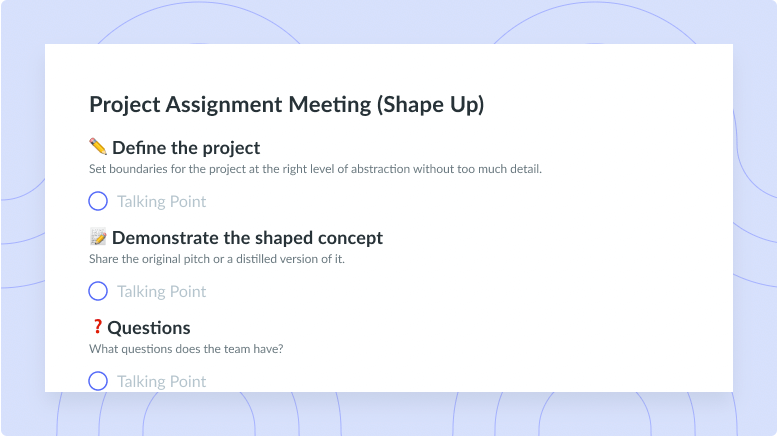
![1-on-1 between CEO and Executive [Lobbyist Association] Template](https://fellow.app/wp-content/uploads/2021/09/1-on-1-between-CEO-and-Executive-Lobbyist-Association-preview.png)










